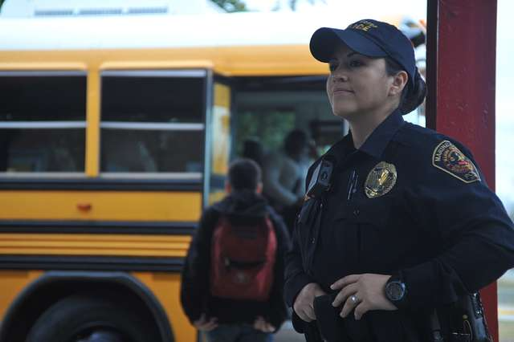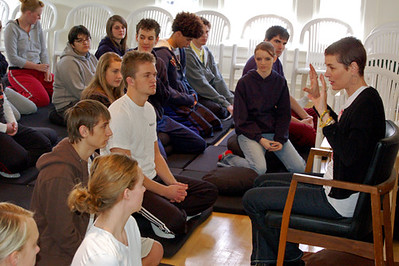20 Speaking Informatively Through Deliberative Presentations
Chapter Objectives
Students will:
- Contrast different types of informative speaking.
- Explain the role of deliberative presentations in engaging public controversies.
- Demonstrate steps in the process of forming a deliberative presentation.

The number of US school shootings in recent years has many Americans alarmed and calling for change. But figuring out what should change, how, and who is responsible are difficult questions to answer. Should we tighten security measures at schools? Better drill students and staff for such emergencies? Increase the number of police officers and enhance their training? Decrease classroom sizes? Provide affordable and easy access to mental health services? Stiffen background checks for purchasing guns? Ban assault weapons?
Difficult cases rarely offer one right answer or one universally satisfying way forward. Instead, they raise the need for communities to learn about the problem, possible options, and opposing perspectives before making decisions. In this chapter, we turn to a form of speech that effectively meets that need: informative speaking.
In what follows, we first broadly outline the major features and types of informative speaking. The remainder of this chapter and the following chapter focus on one version of informative speaking: the deliberative presentation. We will define and explain the deliberative presentation as an especially useful way to address public controversies. We will then explore the first three steps of preparing a deliberative presentation: selecting a wicked problem, researching the problem, and discovering a range of approaches that address the wicked problem. Chapter 21 will discuss the remaining steps of framing and organizing the problem for deliberation.
Informative Speaking
In informative speaking, a speaker educates their direct audience about a topic without leading them toward a particular position, conclusion, or outcome. Recall from chapter 10 that the direct audience consists of people who are exposed to and attend to your speech.
In this type of speaking, you set your personal preferences aside and present a neutral, fair, and inclusive understanding of the topic. Of course, none of us can remain completely impartial, and staying impartial does not prevent you from sharing relevant, personal experiences. The goal is to do your best to keep your opinions in check to allow audience members to arrive at their own conclusions.
 The need for informative speaking in civic affairs may not be self-evident. After all, information has never been easier to obtain for people with access to the internet. However, the material provided through the internet can quickly become overwhelming, and not all of it is reliable.
The need for informative speaking in civic affairs may not be self-evident. After all, information has never been easier to obtain for people with access to the internet. However, the material provided through the internet can quickly become overwhelming, and not all of it is reliable.
Few of us have the time—or, at least, take the time—to thoughtfully discover, evaluate, read, and process information from multiple sources. Instead, we may glance at headlines or articles in our social media feeds or even abandon the effort altogether. It can be tempting to leave civic affairs to public officials and specialists to save ourselves the trouble. Consequently, we remove ourselves from decision-making that may directly impact our quality of life.
Informative speaking, then, is critical to democratic participation. An informative speech empowers listeners by drawing attention to public concerns, presenting relevant and reliable information from credible sources, and helping a community make sense of that information.
Types of Informative Speeches in a Civic Engagement Context
Different kinds of informative speeches enable civic engagement in various ways. In this section we briefly describe three types of informative speeches that aid democratic participation: instructional speeches, problem-focused speeches, and deliberative presentations.
Instructional Speeches
An instructional speech explains or teaches an audience about a process, concept, or entity to help community members participate in civic affairs more easily and confidently. This type of informative speech stops short of actively promoting involvement or prescribing particular actions. Such advocacy becomes persuasion and is the focus of chapters 24 and 25. Instead, you simply lay the groundwork for involvement should an audience member choose to take part.
Box 20.1 Instructional Speech Topics
In instructional speeches, speakers provide information so audience members can better understand and participate in the community’s affairs. For example,
- How does a meeting run? You might educate new members of an organization about the rules. Several of this textbook’s authors, for instance, have delivered an instructional speech to new professors about the parliamentary procedures used during faculty meetings. We sought to educate new members so they could understand what was happening during a meeting and more easily participate.
- What are club expectations? You might deliver an instructional speech about the history, membership, and expectations of a club or organization you belong to at your school.
Notice that in both examples, speakers would not explicitly advocate for participation in faculty meetings or campus organizations.
Problem-Focused Speeches

Problem-focused speeches identify, describe, and explain a civic problem. The goal is to help an audience understand the issue and possibly prepare them to address it. Most typically, a problem-focused informative speech will explain the problem’s history, impacts on those affected, probable cause(s), and major components. Such a speech avoids naming or advocating a solution, though it might explain previous efforts to address the problem.
Box 20.2 Problem-Focused Speech Topics
The emphasis of a problem-focused speech can vary based on your audience:
- If your audience is unaware of a problem, you might highlight and explain it.
- Example: A dangerous intersection in town you notice on your commute to campus but your peers miss because most live on-site.
- If your audience is aware of the problem but perceives it as too minor to merit immediate action, you can increase your audience’s sense of urgency about a problem.
- Example: The overpopulation of animals at your community’s animal shelter. Most people are aware that animal shelters fill up with stray animals. However, they may not appreciate exactly how many animals are left at the shelter daily, the stress animals experience in tight quarters due to overcrowding, and the high costs associated with supporting (or, sadly, terminating) unwanted animals.
- If your audience misunderstands a well-known problem, you should strengthen and even correct their knowledge about it.
- Example: The rising cost of college tuition. An issue like this is broadly recognized as problematic, but some community members may know little about why your college raises tuition or what trade-offs it must make to avoid doing so. A problem-focused speech could verify, supplement, and possibly correct popular beliefs about the problem.
Deliberative Presentations
A deliberative presentation strives to fairly and evenhandedly describe a civic problem and multiple approaches to solving it. Emphasis is placed on the benefits and drawbacks of each approach. A deliberative presentation functions as the setup or preparation for a deliberative discussion, which is a group conversation through which a community, guided by one or more moderators, examines a complex public problem and a range of available solutions to ultimately arrive at a choice or conclusion. Together, the deliberative presentation and subsequent discussion form the deliberative process (also referred to simply as deliberation). The deliberative process involves a presentation of a problem and multiple options and a subsequent moderated discussion of those options (though the format and timing of both parts can vary).
Box 20.3 The Deliberative Process
|
The Deliberative Process = |
||
|
Deliberative presentation |
+ |
Deliberative discussion |
|
Description of a civic problem and multiple approaches to addressing the problem |
|
Guided public conversation about the problem and approaches that ends with a choice |

The nature and emphasis of the deliberative process is educational. We want to better understand the problem and investigate each solution in the most open manner possible. Note the emphasis on probing and contrasting solutions to the problem, unlike a problem-focused speech.
Indeed, the ultimate end goal—and a key distinguishing feature of the deliberative process—is that the participating community chooses the option it wants to pursue or at least outlines the next steps required. Ideally, the process results in consensus on a way forward, but that may not always be the case. Eventually, traditional persuasive efforts and/or voting may be appropriate.
 The deliberative process is ideally suited to address a public controversy, or what others have called a wicked problem—that is, an issue that is difficult to resolve because it involves diverse values and perspectives about what the problem is, who is responsible, and how it should be addressed.[1] A wicked problem is widely acknowledged as a problem and draws broad concern locally, nationally, or even internationally. It may be persistent, such as the issues of gun violence and immigration; or it may become prominent at certain moments and then die down only to resurface again later, such as controversies over oil spills and nuclear power. The point is that wicked problems are never completely resolved; they can only be gradually improved. In contrast, tame problems are simpler issues that can be solved with expertise.
The deliberative process is ideally suited to address a public controversy, or what others have called a wicked problem—that is, an issue that is difficult to resolve because it involves diverse values and perspectives about what the problem is, who is responsible, and how it should be addressed.[1] A wicked problem is widely acknowledged as a problem and draws broad concern locally, nationally, or even internationally. It may be persistent, such as the issues of gun violence and immigration; or it may become prominent at certain moments and then die down only to resurface again later, such as controversies over oil spills and nuclear power. The point is that wicked problems are never completely resolved; they can only be gradually improved. In contrast, tame problems are simpler issues that can be solved with expertise.
Box 20.4 Wicked Versus Tame Problems
|
Wicked Problems |
Tame Problems |
|
How can we reduce the number of school shootings? |
What is the most effective metal detector? |
|
How should we limit the spread of a health pandemic (COVID-19, etc.)? |
What are risk factors for getting sick? |
|
What should universities do to survive amid increasing costs and competition? |
How does the average increase in tuition at public universities compare with private colleges over the past fifteen years? |
Wicked problems are marked by contingency, a condition in which events and circumstances are dependent on several variables that evolve in unpredictable ways. Thus, the effects of any decision made about a wicked problem cannot be fully anticipated.
Box 20.5 The Contingent Nature of Wicked Problems
What are the answers to these questions about how to end or reduce school shootings?
- Will increasing security at schools lessen school shootings and bring them to an end more quickly? Or will such measures traumatize kids or make them feel like criminals?
- Would stronger background checks for gun ownership and bans on certain weapons decrease shooters’ access to weapons? Or will they leave kids and teachers more vulnerable to attacks?
- Might providing more affordable mental health services steer possible shooters toward more productive outlets? Or will that provision shift necessary funding away from police staffing, training, and protective gear?
We cannot know the answers to questions like these with absolute certainty because too many unpredictable variables influence the outcomes. If we knew the answers with certainty, disagreements and discussion would be unnecessary because the best decision would be self-evident.
Because informative speaking is educational, it typically takes place before we select or advocate for any solution, conclusion, or belief. Communities need to know and understand before they can select and decide. Whatever the type of speech, informative speaking should result in an improved understanding of the topic addressed. In the case of deliberative speaking, audience members should also have a thorough review of several possible solutions. Because of the importance of deliberative presentations, we will focus the remainder of this chapter and the next chapter on the steps involved in producing and delivering such an address.
Preparing a Deliberative Presentation
The specific steps you should take to prepare a deliberative presentation include selecting a wicked problem, researching the problem, discovering a range of approaches, framing the issue for deliberation, and organizing the presentation. This chapter will explain the first three steps, and the next chapter will focus on framing and organization.
Box 20.6 Preparing a Deliberative Presentation
- Select a wicked problem.
- Research the wicked problem.
- Discover a range of approaches that address the wicked problem.
- Frame the wicked problem for deliberation:
- Define the problem fairly.
- Identify the trade-offs of each approach.
- Specify the value(s) that motivate each approach.
- Organize the deliberative presentation.
Selecting a Wicked Problem
Developing a deliberative presentation begins with identifying a wicked problem. Your instinct may be to shy away from difficult issues, particularly those you know little about. This reaction is natural, but try to resist it. Take the initiative to educate yourself. Effective democracies rely on participants who learn and help make decisions about civic matters—and who do not shy away from conflicting viewpoints. In fact, democracy thrives on diverse views and on reasoned, thoughtful discussion. As a student of public communication, learn to embrace productive conflict as a healthy element of democracy. You cannot avoid conflict without also avoiding participation in democratic governance.
Box 20.7 Identifying a Wicked Problem
1. List all the communities of which you are a part: your college, hometown, church, employment, online activity, state, and so on.
a. Think about the problems each group is facing. Write them down.
b. Look over your list. Which of the problems you identified meets the definition of a wicked problem: It is difficult to resolve because it involves diverse values and perspectives about what the problem is, who is responsible, and how it should be addressed.
2. Ask yourself, “What’s important to me? Which issues really matter to me? What is upsetting to me?” Write down your answers.
a. Do other members of your community share these concerns?
b. Which of the problems you identified meets the definition of a wicked problem?
Researching the Wicked Problem

Once you have selected a wicked problem, use the advice provided in chapters 8 and 9 to research the issue and to identify and correct misinformation and disinformation—particularly about the problem, its background, impacts, and contributing factors.
Box 20.8 Researching Information About the Wicked Problem of School Shootings
If you focused your deliberative presentation on school shootings, what kinds of information should you find in your research? What would the audience need to know so they could base their opinions on accurate knowledge rather than presumptions, guesses, or misinformation? We would recommend you research the following:
- previous school shootings (how many, their locations, their nature [targeted or as a result of a dispute])
- number of victims
- demographic information about the shooters
- whether and how the number is trending compared to previous years
- past responses to school shootings (by police, medical personnel, legislative bodies, schools and students themselves)
- prevention efforts (such as wellness and security measures taken by schools)
What else might you include?
 Factual information alone, however, cannot resolve a wicked problem. You must also consider the people impacted by, and invested in, the issue. In chapter 10, we identified the implicated audience as people affected by your message if it succeeds. We also introduced the concept of personal stakes, which are an individual’s financial, material, and/or psychological investments that can be improved or worsened based on how an issue is addressed. A slight variation on implicated audiences and personal stakes is the idea of stakeholders, or groups and organizations that have vested interests in a wicked problem and its outcome because of the impact on their lives.
Factual information alone, however, cannot resolve a wicked problem. You must also consider the people impacted by, and invested in, the issue. In chapter 10, we identified the implicated audience as people affected by your message if it succeeds. We also introduced the concept of personal stakes, which are an individual’s financial, material, and/or psychological investments that can be improved or worsened based on how an issue is addressed. A slight variation on implicated audiences and personal stakes is the idea of stakeholders, or groups and organizations that have vested interests in a wicked problem and its outcome because of the impact on their lives.
Every public issue impacts many different groups, so you should also research multiple stakeholders. Discovering their needs, lived experiences, values, and preferences can help you better understand—and inform your direct audience about—the issue from multiple angles.
 You might also be a stakeholder yourself in the wicked problem you’ve chosen. If so, reflect on your own experiences and interests to inform your presentation. Relying too much on your own knowledge, however, will likely blind you to aspects of the problem you have never experienced or considered because of your standpoint. Recall from chapter 7 that standpoint theory suggests that our social identities influence our knowledge of the world and our perceptions of what is true or normal. In the case of school shootings, for example, our identity is likely to influence our perceptions of shooters, guns, gun violence, and police officers. If you are a white person who lives in a rural setting, for instance, you are more likely to associate school shootings with troubled kids and associate police officers and guns with offering potential safety and protection.
You might also be a stakeholder yourself in the wicked problem you’ve chosen. If so, reflect on your own experiences and interests to inform your presentation. Relying too much on your own knowledge, however, will likely blind you to aspects of the problem you have never experienced or considered because of your standpoint. Recall from chapter 7 that standpoint theory suggests that our social identities influence our knowledge of the world and our perceptions of what is true or normal. In the case of school shootings, for example, our identity is likely to influence our perceptions of shooters, guns, gun violence, and police officers. If you are a white person who lives in a rural setting, for instance, you are more likely to associate school shootings with troubled kids and associate police officers and guns with offering potential safety and protection.
By researching and discovering additional stakeholders, you will discover not only additional perspectives but also how stakeholders are differently impacted by the wicked problem. Indeed, we recommend you research how inequity plays a role in the wicked problem and who it particularly impacts.
Box 20.9 Researching Stakeholders in the Wicked Problem of School Shootings
 Stakeholders that quickly come to mind for school shootings include students and their families, teachers, and school staff members. You might count yourself among these stakeholders as a student who practiced drills in high school, knows a victim of gun violence, or has experienced gun violence firsthand. Consider what insights you can bring from your experience.
Stakeholders that quickly come to mind for school shootings include students and their families, teachers, and school staff members. You might count yourself among these stakeholders as a student who practiced drills in high school, knows a victim of gun violence, or has experienced gun violence firsthand. Consider what insights you can bring from your experience.
Recognize, however, that not all students (or teachers or families) experience the problem similarly. You will find the following, for example:
- People associated with wealthier, rural, and mostly white-populated schools are more likely to fear school-targeted shootings because they largely occur in those settings.
- Students, teachers, and families associated with urban, poor, and mostly minority student bodies are more likely to fear shootings related to disputes and accidents, which occur more frequently at these settings and much more often than school-targeted shootings. Nearly half (47%) of shootings at K–12 schools from 2009 to 2019 were caused by disputes or accidents; only 14% were “school targeted,” such as in Parkland, Florida.[2] Accordingly, students who are minorities are more likely to be victims of school shootings, yet they are less likely to receive news coverage, since “the most violent (and least common) stories [about school shootings] make the headlines.”[3]
- Recognizing the differences will help you and the direct audience to better identify the issue’s complexity and avoid conflating one stakeholder’s experience with another’s.
Also ask yourself, Beyond students, teachers, and their families, who else has a stake in the issue of school shootings and how it’s resolved? You might include the following stakeholders:
- mental health counselors and nurses who aid kids who are traumatized by gun violence or even by practice drills
- community and religious leaders and organizations who strive to help young people resolve grievances without violence
- police officers who are expected to respond swiftly and effectively to anyone inflicting harm on students
- organizations that have a somewhat narrower stake in how the use of guns is addressed, such as reform advocates like Moms Demand Action and rights activists such as the National Rifle Association, not to mention owners of businesses that sell guns and those who promote and teach gun safety
If you pushed yourself even more, you might add stakeholders such as the following:
- legislators who provide school funding, hold police forces accountable, and pass laws that govern gun rights
- news media reporters who make decisions about how to report school shootings
- gender studies educators like Jackson Katz and Richard Majors and Jennifer Mancini Billson who research and teach about connections between masculinity and violence
Your thinking about stakeholders should not result in telling your audience a laundry list of groups. Instead, use this work to clarify for your audience how the wicked problem differently affects the lives and interests of diverse groups and thus why their preferences might conflict. For instance, include examples of differing stakeholders when educating your audience about the wicked problem. As you discover and explain diverse approaches to the problem—a task we turn to next—specify which stakeholders are benefited and harmed by each approach and how.
Discovering a Range of Approaches
Once you have selected a wicked problem and researched its elements and stakeholders, identify a range of approaches to improving the issue. As discussed in chapter 2, we tend to divide issues into two sides, often “for” a policy change and “against” it. This binary approach is popular, but it reduces complicated issues to tidy, oppositional dichotomies as if everyone on each side is in complete agreement and no one from opposing sides agrees on anything.
Box 20.10 Avoid Two Opposing Approaches to the Wicked Problem
The issue of school shootings can easily become a two-sided debate over gun regulation. People are identified as being either
|
for |
or |
against gun regulation |
|
|
which is assumed to mean |
|
|
total prohibition of guns |
vs. |
unrestricted gun access |
Of course, few people hold such extreme views either way. Generally speaking,
- those in favor of gun regulation do not propose that all guns be removed or banned from law-abiding citizens, and
- those against gun regulation are not in support of all persons having unlimited access to all types of weapons.
When we oversimplify positions as one extreme or another, we tend to lose sight of our common problem: “How do we best ensure our children’s safety?” We also overlook more moderate and nuanced options. These could range from waiting periods and increased background checks and registration to “red flag” laws, permits, and legislation based on factors like age, criminal record, or intellectual ability.
Try to avoid getting caught up in two-sided policy debates. Do not make two of your approaches the extremes in a debate and the third approach a halfway measure or compromise between them. Such a setup prompts a debate rather than a deliberation, or it encourages most participants to choose the third option.
Instead, seek a much wider range of approaches. As box 20.11 advises, brainstorming, considering stakeholders’ interests, and researching will help you find suitable and diverse approaches. You might, for instance, discover how inequity or systems of oppression contribute to the wicked problem and focus one approach on targeting such inequity.
Box 20.11 Discovering at Least Three Approaches to a Wicked Problem
The challenge of discovering at least three approaches for a deliberative presentation can be overcome by following a few tips:
- Brainstorm: Write down all the pertinent beliefs, opinions, and specific public actions that come to mind. You can even imagine additional approaches or possible actions that others may not have considered.
- Consider stakeholders: Return to the research you conducted on the stakeholders in this controversy. What policies and approaches did each advocate? Consider interviewing several key stakeholders, following the guidelines provided in chapter 9, to learn more about their experiences, perspectives, and preferred approaches.
- Research the issue: Focus particularly on sources that express public opinions and perspectives, such as letters to the editor or opinion editorials, news interviews, YouTube videos, podcasts, blogs, websites devoted to advocating a group’s perspective, and opinion polls.
As you gather perspectives, preferences, and policy ideas, refrain from evaluating their merit. The sole criterion is that all ideas listed are reasonable. Options that no one in their right mind would choose are not useful for a deliberative presentation.
Then look for repetition or similarities across the ideas so you can sort them into three approaches to present to your audience. By approach we mean a broad category of similar opinions on how to address a wicked problem, typically gathered around a shared logic and value. A single approach should be broad enough to include several, and possibly conflicting, actions by multiple actors.
Box 20.12 Sample Approaches to the Wicked Problem of School Shootings

1. Adopt stronger security efforts, with the logic that if it is more difficult to bring or hide a gun on school property, there will be fewer shootings there.
a. Specific sample actions: Restrict kids to carrying clear backpacks, use metal detectors at entrances, and hire more on-site security officers.
b. People who like this approach would agree with the overall emphasis on security, but they might disagree with each other over which sample actions should be chosen.

2. Improve youth wellness. Such an approach poses the logic that if communities know and attend to young people’s emotional and psychological needs better, then they will be less likely to resort to shooting each other.
a. Specific sample actions: Incorporate daily meditation practices into classrooms, hire more school counselors, offer training in dispute reconciliation, fund community centers, and strengthen family involvement.
b. All these ideas are included in one approach because they emphasize youths’ mental health and wellness, though people attracted to this approach might disagree on which specific sample actions will be most effective.
3. What might be a third broad approach?
Rest assured there is no one right set of three approaches for any wicked problem, and you might even want to present four or five. Your goal is simply to provide a set of truly divergent approaches that account for most, if not all, of the concerns and opinions you discovered about the wicked problem. Everyone in the community who hears your deliberative presentation should be able to find their own outlook somewhere in the approaches you provide.
Summary
Informative speaking educates an audience about a topic without biasing them toward a particular position, conclusion, or outcome. It helps provide the understanding necessary for productive public exchanges and decision-making to follow. Specifically, this chapter covered the following:
- By providing an audience with reliable information about public affairs, informative speaking helps community members participate in civic concerns more confidently and actively.
- Two common types of informative speeches include instructional speeches, which teach an audience about a process, concept, or entity, and problem-focused speeches that describe and explain a civic problem.
- A third type of informative speech is a deliberative presentation, which fairly and evenhandedly describes a wicked problem and multiple approaches to solving it with an emphasis on the benefits and drawbacks of each approach.
- Three of the five steps to form a deliberative presentation are selecting a wicked problem, researching the problem, and finding a range of approaches.
Key Terms
approach
contingency
deliberative discussion
deliberative presentation
deliberative process
informative speaking
stakeholders
tame problem
wicked problem
Review Questions
- What is informative speaking, and what role can it serve in civic affairs?
- What are three different types of informative speeches, and how do they differ?
- What does it mean that wicked problems are marked by contingency?
- What are the first three steps for developing a deliberative presentation?
Discussion Questions
- Which of the three types of informative speaking discussed in this chapter have you seen or experienced? What did you learn?
- Think about the communities of which you are a part. What might be suitable topics for an instructional speech, problem-focused speech, or deliberative presentation for one of those communities? What topics or problems need clarification and understanding?
- Choose a current wicked problem and find or name three conflicting approaches to how to solve it. What logic does each approach apply? What sample actions does each include, and what value motivates each approach? What do you learn or notice by contrasting the approaches?
- Brian W. Head identifies Horst Rittel and Mel Webber as originating the term wicked problem in 1973. See Brian W. Head, Wicked Problems in Public Policy: Understanding and Responding to Complex Challenges (Palgrave Macmillan, 2022). ↵
- U.S. Government Accountability Office, K-12 Education: Characteristics of School Shootings (Washington, DC: U.S. Government Accountability Office, June 9, 2020), https://www.gao.gov/products/gao-20-455, archived at https://perma.cc/379H-MDPP. ↵
- Tiana Gaudette et al., “Media Coverage of School Shootings: A Distortion Analysis of Incident and Perpetrator Characteristics,” Crime & Delinquency, published online November 28, 2023, https://doi.org/10.1177/00111287231211263. ↵

